By Susanna Ives
The following was written with the help of my Scandinavian in-laws. I can’t vouch for the historical accuracy of the information, but it makes for a great story.
The Scandinavian Christmas celebration starts on the first Sunday of advent. Back in the old country, the nights are long and the days are dark this time of year. Children spent their evenings making Christmas tree decorations out of paper. We bought our decorations at IKEA, but here is a star my husband made back when he was a young sprout.
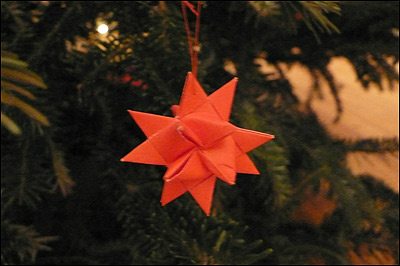
IKEA also supplied our traditional Julbock or Yule Goat. The straw Yule goat dates back to times when a goat was slaughtered during the pagan Yule festival. Here is our pagan Julbock.
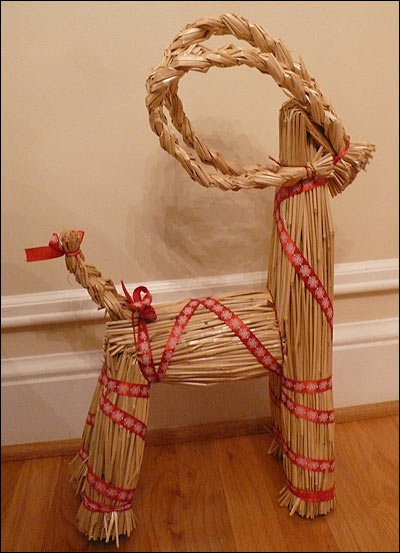
My husband feels I should include this link about the giant Julbocken i Gävle in Sweden.
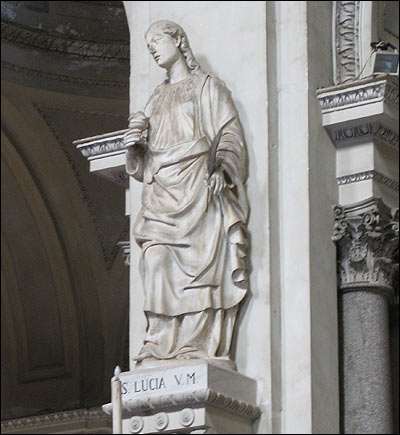
Without fail, every December 13th, my husband and I forget Santa Lucia day. Santa Lucia is a Sicilian saint. Above is a picture of a Santa Lucia's statue that my in-laws photographed during their trip to Sicily. The Scandinavians became acquainted with her when the Normans (men of the north) occupied Sicily. Santa Lucia is associated with light during the dark wintertime.
On the morning of the 13th, the eldest daughter of the house puts a wreath of candles on her head and serves coffee and Lucia buns to her family. Below is a Santa Lucia bun made by my Danish mother-in-law.
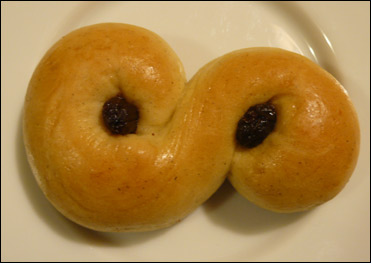
My mother-in-law tells me Santa Lucia is a Swedish and Norwegian tradition, and she only observes the day because her husband is Swedish. However, my mother-in-law bakes delicious Santa Lucia buns and brings them to our house every year to enjoy at Christmas. She also makes traditional Danish Christmas cookies: ginger snaps, vanilla rings and almond cookies. Very tasty.
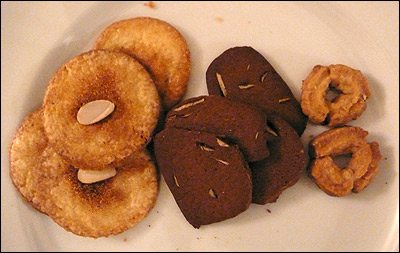
The next big day in the Christmas celebration is Lillejuleaften which means the evening before Christmas Eve. On this day, the grownups would cut down the Christmas tree, bring it inside, and decorate the branches with candles, glass bulbs, and the children’s paper decorations. In olden times, the children weren’t supposed to see the tree until Christmas Eve, however, now decorating the tree includes the entire family.
Typically, we have the tree set up before Lillejuleaften so we can concentrate on the smorgasbord. We have to shop at farmer’s markets, IKEA, and specialty grocery stores to gather various herrings, Greenland shrimp, smoked salmon, cold cuts, hard rye bread, schnapps, and a variety of cheeses including Fontina, Havarti, Port Salute, blue cheese and others. The sandwiches are open faced so the breads have to be strong enough to support loads of herring, egg, caviar and other yummy things. My father-in-law tells me that the schnapps is drunk for affect, not taste. The strong spirits warms and cheers you, but must be chased with beer, else it will burn your throat. Back in the day, there was formal drinking or open drinking at smorgasbords. Formal drinking means you must drink when the host does. My father-in-law contends this is how the Danes drank the British under the table. He also says that the advantage to formal drinking was no Viking could cut your throat as you drank. There are two sizes of schnapps glasses: large Swedish and small Danish.
At the smorgasbord, the guests make a sandwich with fish and then wait for the host to Skål, a Scandinavian toast for good fortune andhealth. Skål means drinking vessel but my family claims the term actually means drinking out of the skull of your enemy. Then the host welcomes everyone and wishes them happy glaedelig jul.
A proper smorgasbord should take several hours. The last course is coffee. Then the family and friends take a walk in the snow or such and gather a few hours later for a supper of pork loin, potatoes and red cabbage.
In Denmark, you eat a light breakfast and lunch on Christmas Eve or Jule aften because the kitchen is taken up preparing a goose stuffed with prunes and apples soaked in Port. The bird is accompanied by more potatoes and red cabbage. For dessert, you have rice, almond and cream pudding topped with hot cherry syrup. (I have a recipe if anyone is interested.) You must be very careful when you eat this dessert, for it is really a treacherous family game. You see, hidden in the pudding is one whole almond. The lucky family member who gets the almond wins a marzipan pig. In our home, in lieu of such a pig, we give out a chocolate orange.
Meanwhile, across the Kattegat in Sweden, Lutefish is served (or was). This, ummm, delicacy, is cod that has been cut by a carpenter saw and soaked in water and lye for months. Lutefish is tasteless except for the pepper and onion cream sauce and can turn your silver black. My husband gave me a little chemistry lesson on preserving fish. According to him, you have three ways to preserve fish. 1.) pickle it and make sil. 2.) let the fish rot and make surstömming. 3.) freeze dry. To reconstitute the dehydrated fish, you have mix it with lye and water and then wash away the lye.
The Swedes also had veal jelly with vinegar, pickled anchovies including the heads, and potato sausage made with pork, potato, and veal. After the meal was done and the dishes washed, glasses of Cognac were passed around.
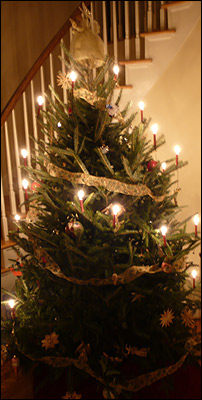 In Denmark, the grownups would open the door to the room housing the Christmas tree and let the children see the decorated tree with all the candles burning. Everyone danced around the tree and sang carols. (I have a CD of Danish Christmas music if you want to know the name). In our house, we light the tree candles, have a fire extinguisher handy, and keep the kids far away from the tree. We don’t keep the candles burning for very long.
In Denmark, the grownups would open the door to the room housing the Christmas tree and let the children see the decorated tree with all the candles burning. Everyone danced around the tree and sang carols. (I have a CD of Danish Christmas music if you want to know the name). In our house, we light the tree candles, have a fire extinguisher handy, and keep the kids far away from the tree. We don’t keep the candles burning for very long.
If you were Swedish, on Christmas morning you went to church at 5:30 to greet the sun while the Danes slept in. After church, the Swedes opened their gifts, ate ham for dinner and then took a nap. The Danes had another smorgasbord on Christmas and then continued to party for second Christmas day or Anden Juledag.
---------------------------------------------------------------
Susanna Ives is the author of RAKES AND RADISHES. You can learn more about her book at www.susannaives.com
- 1 quart of milk
- 1 tablespoon of sugar
- 3/4 cup of Arborio, sushi or short-grain rice
- 3/4 blanched and chopped almonds
- 1/2 vanilla bean
- 1/2 pint of chilled heavy cream.
Bring milk to a boil in a double boiler. Open vanilla bean. Add seeds and pod to milk. Add rice. Cover and let shimmer until rice is soft but not mushy. Pour rice and milk into bowl. As cooling, add sugar and almonds.
Before serving, whip heavy cream until thick. Fold in rice. Stir in whole almond.
Serve hot cherry sauce separately.

8 comments:
Interesting post. The food sounds terrific!
Loved it. great description of Scandanavian celebrations.
Oh my gosh, are you bringing back some pretty strong memories for me--and seriously making me crave my mother's cooking. Skal!
You did reawaken some memories for me. My Dad's parents came here from Denmark in their early twenties and then in 1986 we had a Swedish exchange daughter. I certainly do recognize a lot of the photos and traditions you mentioned. You forgot grog - a hot drink with raisins in it, though. We tried it a couple of times, but not to our liking.
Since it was my Grandfather's birthday on Christmas Eve, we always made sausages and the beloved aebleskievers (a Danish pancake that looks like a golf ball). We still carry on this tradition.
My Dad never did tire of open-faced sandwiches and we never did tire of the shortbread cookies my Grandmother made - they literally melted in your mouth.
Merry Christmas!
That was a great post, Susanna! I'm interested in the pudding recipe when you have the time. Sounds yummy! Thanks and Merry Christmas!
Had NO idea the Scandinavians occupied Sicily! In fact, your blog was chock-a-block with interesting stuff I never heard of. Love the jul goat! (And yes, followed your husband's link.) The treats look scrumptious.
I'd like the pudding recipe, too!
Thanks everyone. My in-laws are tickled that people are reading the post. I have added the rice and almond recipe to the blog post.
Susanna & your in-laws,
Loved reading all this, most of which I didn't know at all,
Thanks so much,
Suzi
Post a Comment